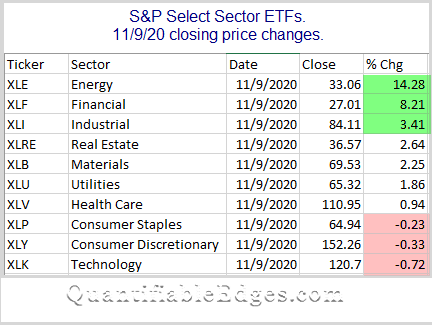The purpose of this post is to test whether we can use a simple risk on / risk off indicator for our portfolio. This indicator was taken from the paper "Risk on- Risk off: a regime switching model for active portfolio management" by José P. Dapena, Juan A. Serur and Julián R. Siri.
Their purpose is "to evaluate if there is an active management premium by testing performance with a non-conventional multifactor model, constructed with a Hidden Markov model which depending on the market states signaled by the level of volatility spread". In other words, and to make it simple: "when the most likely state is one with a low volatility spread, which means that the realised volatility is increasing more than the implied volatility, the strategy allocates the funds in short-term Treasuries, and the strategy becomes 'risk off'; otherwise, the strategy allocates the funds in the S&P 500, where the strategy becomes 'risk on' ".
Rules:
- Our 'risk on' allocation is going to be the SPY as a proxy of the S&P 500; and our 'risk off' allocation will be the TLT as a proxy for Treasuries.
- Option1 will be a portfolio where:
- 'Risk on' if yesterdays' realized volatility is lower than implied volatility.
- 'Risk off' is yesterday's realized volatility is greater than implied volatility.
- Option2 wil be a portfolio where:
- 'Risk on' if last five days' increase in realized volatility is lower than last five days' increase in implied volatility.
- 'Risk off' if last five days' increase in realized volatility is greater than last five days' increase in implied volatility.
- VIX Index is going to be our proxy for implied volatility.
- Our window to calculate the realized volatility will be three weeks or fifteen days.
- Python code can be downloaded here.
Therefore, we will have four different portfolios: a buy & hold in the SPY ETF, a 60/40 portfolio where we invest 60% of the portfolio in the SPY ETF and 40% in the TLT ETF, the Option1 portfolio and Option2 portfolio. These are the equity curves for all four portfolios for the last 17 years:And the corresponding drawdowns for each of the four portfolios are:Finally, all descriptive statistics are shown below:As we can see above, both 'Risk on' / 'Risk off' portfolios outperformed all other portfolios in terms of 'Total Return' and 'Maximum Drawdown'. However, if we take into account volatility, only the Option1 portfolio got a better 'Sharpe Ratio' than the 60/40 portfolio, mainly because its 'Annual Return' doubles the one achieved by the 60/40 portfolio.
Results are very similar to those shown in the paper in terms of Sharpe Ratio (0.89) and Max Drawdown (-26%), the paper shows an Annual Return of 11.36% with a 12.71% volatility.
We can conclude that volatility spread could be a good indicator for timing a risky portfolio. However, we have to keep in mind that transactions costs were not taken into account in this simulation; that can change the results since we are going long and short almost everyday. Probably, it will be better to look at weekly or monthly rotations.
We will keep studying it...










